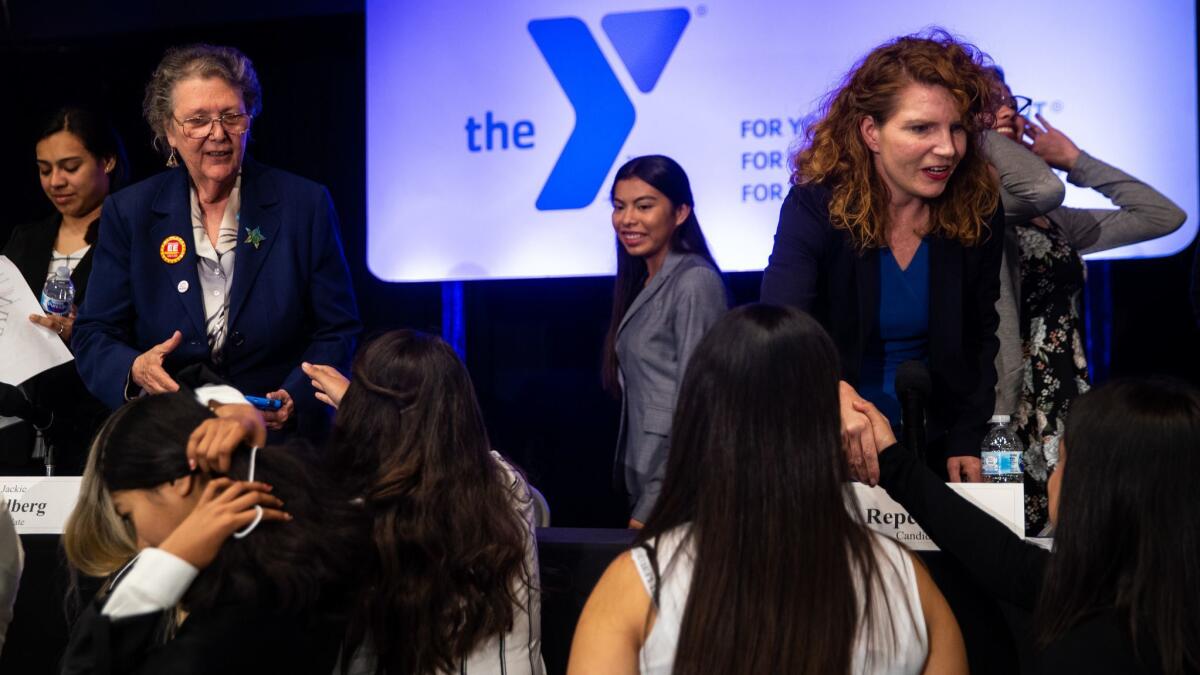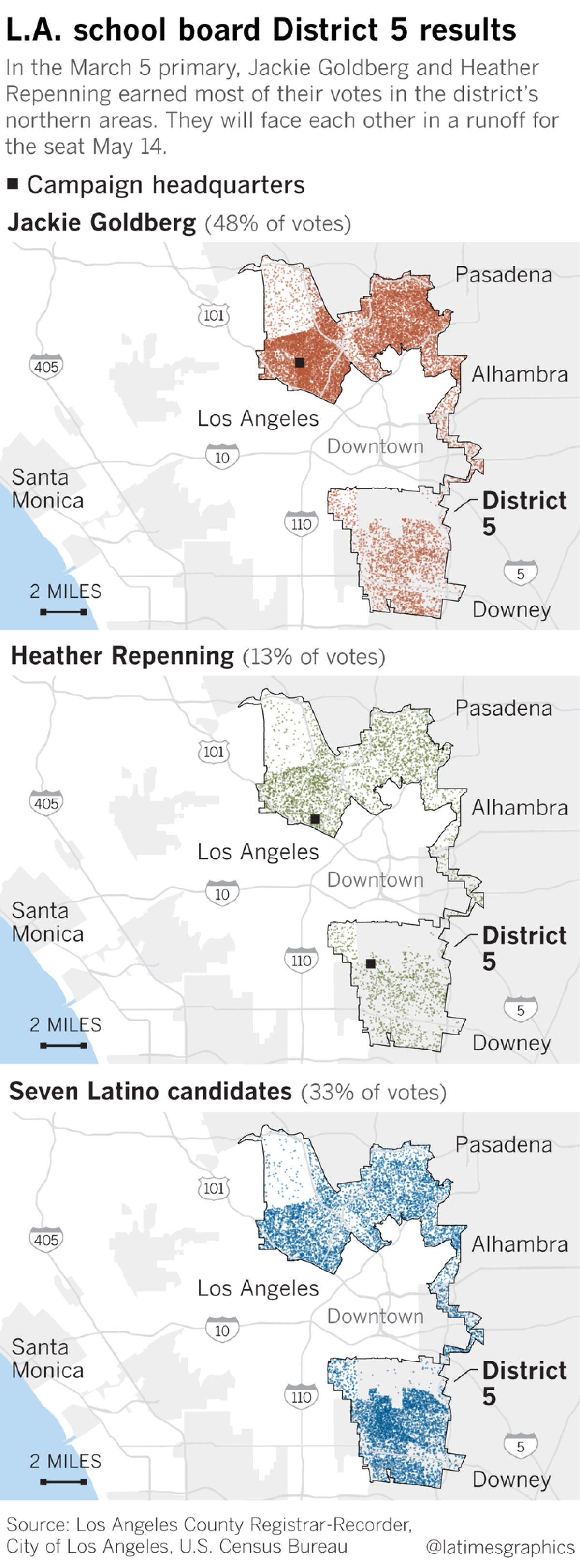In majority-Latino LAUSD, this election will tip the board mostly white

Maria Villatoro had a few things on her checklist that would sway her vote for her kids’ new school board member: They should make the superintendent work harder, visit schools in her southeast Los Angeles neighborhood more often — and preferably, be a Latina, who might better understand the needs of her community.
But in the Tuesday runoff election, she will have to choose between two white candidates in Board District 5, even though about 8 in 10 residents are not white and nearly 90% of the district students are Latino.
The oddly shaped district includes increasingly upscale northeast L.A. communities such as Silver Lake, Echo Park and Eagle Rock and the lower-income, majority-Latino cities of Bell, Huntington Park, South Gate and Cudahy in the southeast.
It was redrawn about 15 years ago to ensure the Latino vote would not be diluted. The forces of gentrification have complicated those efforts, and the fact that there are no Latino candidates left on the ballot disappoints some in the district.

The election will have significance beyond its boundaries, no matter the outcome. Four of the board’s seven members will be white in a school district where 9 in 10 students are non-white.
The numbers underscore that even though Latinos now make up nearly half the population of Los Angeles, they still lag behind in voting rolls and political clout in parts of the city. Some Latinos in the school district are not citizens, so they’re not eligible to vote. But even among those who are qualified, voter turnout in the heavily Latino southeast portion of Board District 5 remains low.
How the candidates are trying to connect
Villatoro, whose son attends Fishburn Avenue Elementary in Maywood, said she’s most worried about cuts in arts classes, counselors and nurses. In the primary, she voted for Cynthia Gonzalez, a Latina from Huntington Park who she believed could fix those issues and best understand Latinos’ unique needs.
“For me, it would be important to have a Latino [on the board],” she said. “They understand the culture and the trauma that kids have in certain neighborhoods.”
But it was two white women — Jackie Goldberg and Heather Repenning — who emerged from a crowded pack of 10 candidates — seven of them Latino — to fill the seat left vacant by the resignation of a Latino, Ref Rodriguez, who pleaded guilty to a conspiracy charge related to campaign finance allegations.
Both candidates said they believe that Latino representation is important and vow to aggressively advocate for the communities in the district.
And voters appeared to embrace Goldberg’s message. She carried almost half the vote, but Repenning edged out Graciela Ortiz, a Latina school counselor and Huntington Park City Council member who won almost every precinct in the southern part of the district, by just 31 votes.
Check back Tuesday, May 14 for the school board election runoff results.
Goldberg, a veteran politician, has argued that she was the only candidate with enough name recognition to ensure a charter school-backed candidate would not be elected.
“I believe it’s a Latino seat,” she said in an interview. “But I will tell you, in all honesty, I don’t believe that we had any chance of keeping a fourth vote from being a charter vote unless I ran.”
Repenning, whose daughter attends a district school, said she entered the contest to represent parents and to be a neutral voice on issues affecting the teachers union and expansion of charter schools.
“I understand that it’s important for our students to have leaders that look like them. I get it, 100%,” Repenning said. “You know, the way I make up for that is that … I believe that I can represent the value of, you know, wanting to make sure that our kids have the best possible opportunities and that we have equity, that we have a fair system that works for everyone.”
Both said they believe they can represent a diverse population, and have the backgrounds to be powerful advocates for kids and parents.
In the 2015 election, southeast voters were partially responsible for ousting white incumbent Bennett Kayser in favor of Rodriguez, said Gabriella Barbosa, a policy analyst for the Alliance for a Better Community, a Latino advocacy group.
During the March primary election this year, there were nearly three times as many votes cast in the northern part of District 5 as in the southeast.
“That mismatch in LAUSD is particularly compounded by the non-citizen population,” said Thomas Saenz, president and general counsel of the Mexican American Legal Defense and Educational Fund. “So there are lots of parents who can’t vote and … lots of voters who aren’t parents.”
In appealing to divergent constituencies, Repenning and Goldberg are taking different approaches.

Goldberg is relying on her northeast voter base to carry the runoff as she did the primary, where she won 48% of the vote.
Repenning, meanwhile, is trying to keep her northeast votes and win over supporters of Ortiz, who has since endorsed Repenning and mobilized voters and volunteers to support her.
And voters are responding to the women’s messages in different ways.
Villatoro, for example, has shifted focus to Goldberg, who Gonzalez endorsed and who she believes has more education experience and exudes more confidence in a leadership role. Goldberg was a teacher for 16 years, served on the school board in the 1980s, and was a member of the L.A. City Council and state Assembly.
Goldberg’s campaign office is in the northeast, she said, “because it’s 75% of the voters.” But if elected, she wants to set up her headquarters in the southeast because “I feel like [those residents] get left behind.”
Some of Repenning’s supporters say the mere fact that she speaks Spanish makes her a winning candidate.
Repenning learned the language while teaching in Honduras two decades ago and has spoken Spanish, with some translation help, in debates and town halls. (Goldberg has said she speaks basic Spanish.) She vowed to have a multilingual staff and work to better understand the daily experiences of Latino students.
“One feels good to be able to understand her and that she tries,” said Remedios Ochoa Reyes, whose 10th-grader attends Alliance Margaret M. Bloomfield High School, a charter school that is within District 5 boundaries and receives public funds, but is run privately.

Does representation matter?
Both candidates said they would have multilingual staff and pay attention to issues that southeast voters have said are important, particularly special education, and continue soliciting feedback from southeast constituents, including candidates they defeated.
Supporters of Repenning and Goldberg said they, too, understood the political and racial dynamic at play — but made practical choices.
Emiliana Dore, a white Atwater Village resident and mother of two, said Goldberg has long committed to advocating for minorities and low-income communities. She liked that Goldberg is vocal and knows the issues well enough to battle with the board when necessary.
“I would love … someone who’s a native Spanish speaker because representation does matter,” Dore said. But ethnicity and language shouldn’t be the only factors in choosing a board member, she said.
The impact of a Latino board member goes beyond language and representation.
A 2009 survey of school board members across California conducted by the Public Policy Institute of California, found that Latino board members “are more likely to see a variety of problems as serious, particularly such issues as low levels of college attendance or school and community condition.”
White trustees, meanwhile, “are more concerned with the involvement of the state and federal government in school policy.” Latino board members are also more likely to advocate for immigrant students’ needs and for more teachers and school leaders of color.
Yolie Flores, who held the District 5 seat before Kayser, said she felt that difference when she was on the dais from 2007-2011.
“I had many experiences that what I was advocating for … as school board member, some of my colleagues just couldn’t understand why that mattered,” said Flores, who grew up in Huntington Park as an English learner.
When she advocated to open parent centers in every school, she saw pushback from a non-Latino board member who represented wealthier communities. She said the district was not as responsive to lower-income Latino constituents who sought a dual-language program as they were to white parents who asked for similar classes.
A recent survey by the Alliance for a Better Community asked about 500 parents (most of whom were Latinos from southeast L.A.) what qualities they believed were most important in a candidate. Almost half of all respondents — 48% — said they preferred a representative who was Latino. However, 90% listed the most important quality as professional education experience. About 84% said they preferred a Spanish speaker.
Parents who answered the survey in Spanish reported that they found it more difficult to get help for their kids and reported lower levels of satisfaction with their schools.
English-speaking respondents were 14 times more likely to say their schools were headed in the right direction.
Barbosa said the most commonly reported needs for Latino parents are English-learner support and resources for special-needs students. Many are frustrated that their schools consistently fail to perform at state standards.
Though Ochoa Reyes says a Latino representative would better serve on the board, she swung her support to Repenning. Whatever happens, she said, not much will change without Latinos heading to the polls and into their schools.
“I wish I had been involved sooner,” she said. “We want the best for our kids, to make this country better and be better in the future. It’s a dream we all have.”
Times staff writers Ben Welsh and Howard Blume contributed to this report.
Reach Sonali Kohli at [email protected] or on Twitter @Sonali_Kohli.
More to Read
Sign up for Essential California
The most important California stories and recommendations in your inbox every morning.
You may occasionally receive promotional content from the Los Angeles Times.












